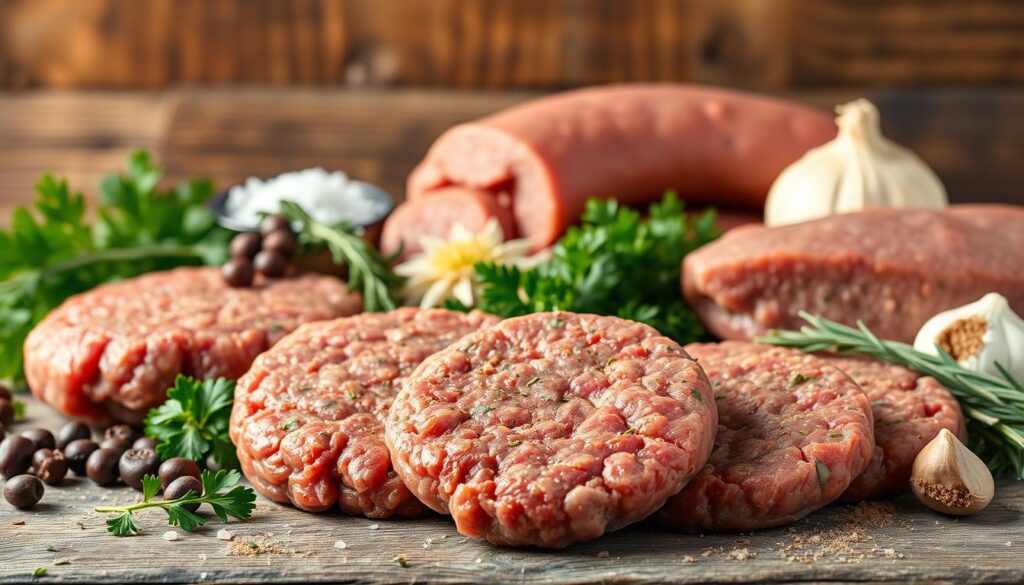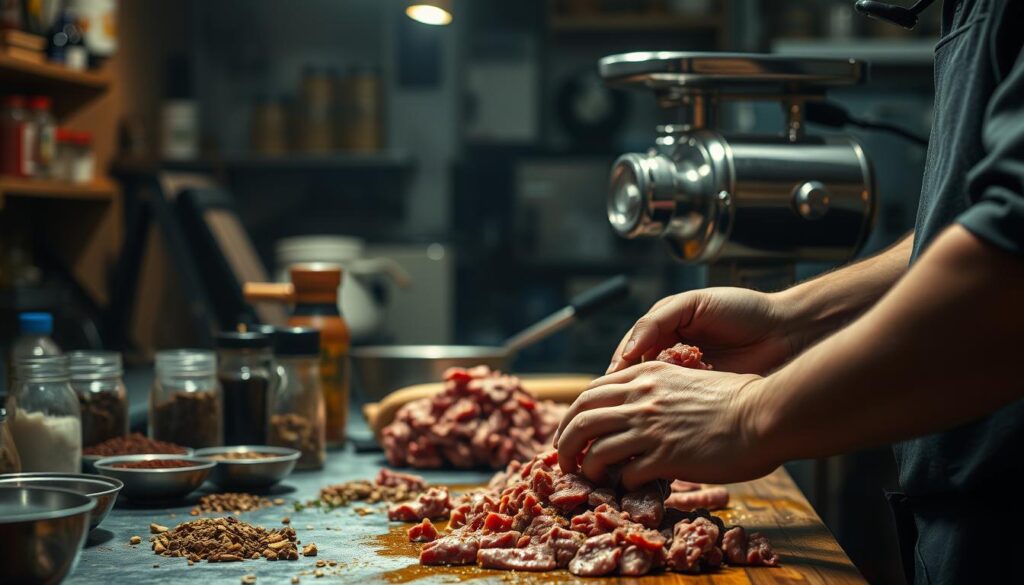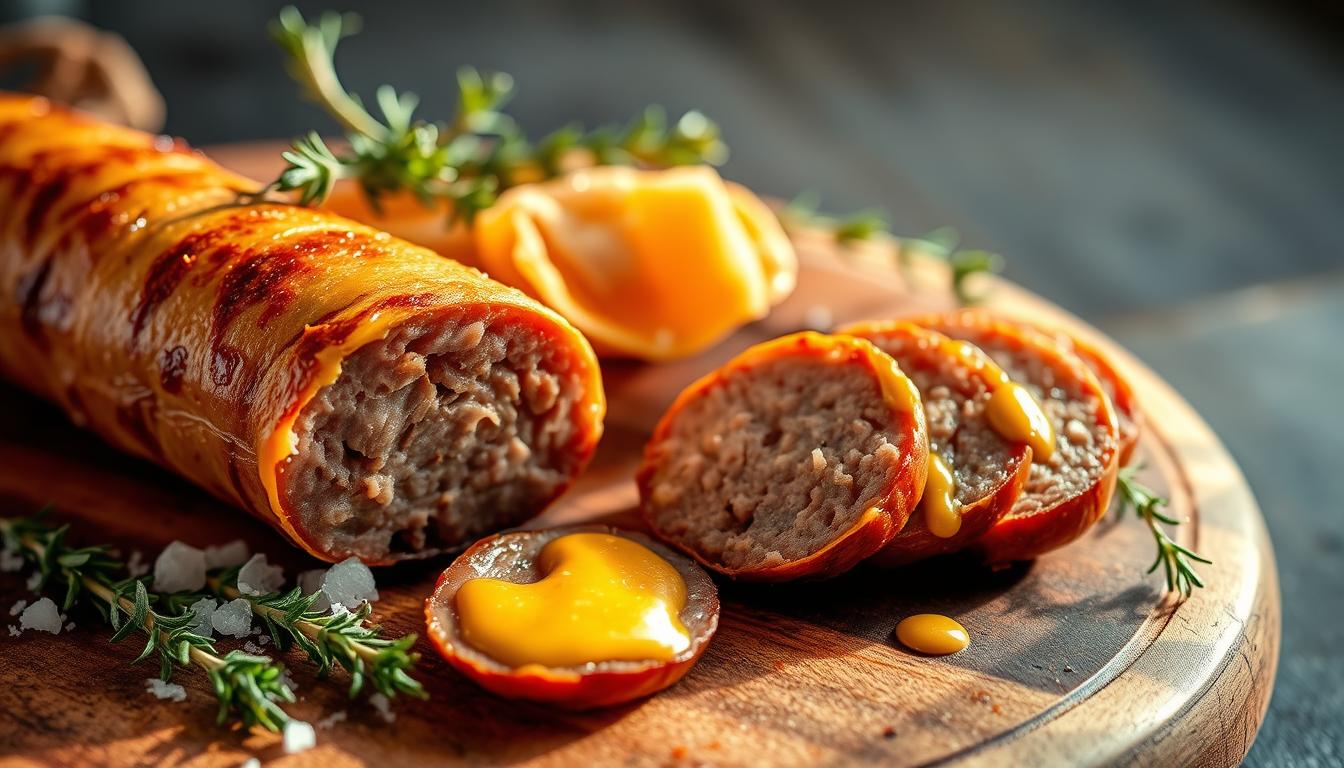Imagine making your meals better with a tasty, gourmet beef sausage. It’s not just delicious but also made with good stuff. By making your own authentic beef sausage, you control what’s in it. This means you get a healthier and more flavorful option than store-bought ones.
With a simple recipe and the right tools, you can make amazing beef sausage. It will be a favorite in your kitchen. Homemade sausage lets you try different flavors and ingredients. This makes it perfect for many dishes.
Table of Contents
Why Homemade Beef Sausage Deserves a Place in Your Kitchen
Making your own beef sausage from scratch changes how you cook. You control what goes into it, making it healthier and tastier. It’s a premium choice for your family’s meals because it avoids preservatives and additives found in store-bought sausages.
Health and Flavor Benefits of DIY Sausage Making
Homemade beef sausage is healthier. You can pick lean meats and control salt and spices. This makes it a better choice than store-bought sausages. Plus, you can season it to your liking, making it more delicious and satisfying.
The table below shows the main differences between homemade and store-bought beef sausages:
| Feature | Homemade Beef Sausage | Commercial Beef Sausage |
|---|---|---|
| Ingredients | Fresh, customizable | Preservatives, additives |
| Flavor | Customizable, fresh | Standardized, may lack depth |
| Healthiness | Healthier, less salt | May contain high salt, preservatives |
The Economics of Making Your Own Sausage
Making your own sausage can save money. Buying meat in bulk and making it yourself is cheaper. You can also make different types of sausages with the same ingredients, reducing waste and saving money. With basic tools, you can make premium beef sausage for less than store-bought.
In summary, making your own beef sausage is a great choice. It’s a way to enhance your cooking and enjoy best beef sausage without the high cost.
Essential Equipment for Crafting Perfect Beef Sausage
Making great beef sausage starts with the right tools. Whether you’re making smoked or natural beef sausage, the right gear is key. It helps get the flavor and texture just right.
Basic Tools Every Sausage Maker Needs
To start making small batch beef sausage, you need some basic tools. A meat grinder is a must for grinding the meat right. You’ll also need mixing bowls for mixing ingredients and a scale for precise measurements.
Other basic tools include a cutting board for prep and a knife for trimming. These tools are essential for a good start.
- Meat grinder
- Mixing bowls
- Scale
- Cutting board
- Knife
Advanced Equipment for Serious Sausage Enthusiasts
If you want to improve your sausage making, consider some advanced tools. A sausage stuffer is great for making natural casings. A smoker adds deep, complex flavors to your smoked beef sausage.
Also, a vacuum sealer helps keep your small batch beef sausage fresh. It removes air from storage bags.
- Sausage stuffer
- Smoker
- Vacuum sealer
Selecting the Best Beef Cuts for Premium Sausage
Choosing the right beef cuts is key for making gourmet beef sausage. The quality and taste of your sausage depend on the cuts you pick. Knowing the different beef cuts and their qualities is important for premium sausage.
Understanding the Ideal Fat-to-Meat Ratio
The fat-to-meat ratio is very important in sausage making. A mix of 20-30% fat and 70-80% lean meat is best for authentic beef sausage. This mix makes your sausage juicy and tasty without being too fatty.
Prime Cuts That Make Exceptional Sausage
For premium beef sausage, use primal cuts like chuck, brisket, or short rib. These cuts offer great flavor and texture. The chuck gives a rich beef taste, and the brisket makes it tender.
Where to Source Quality Beef in America
You can find quality beef at local butcher shops, specialty meat markets, or online in the U.S. Choose suppliers that offer grass-fed or dry-aged beef. This will give your gourmet beef sausage a better taste.
Beef Sausage: The Ultimate Recipe and Ingredients
Making handmade beef sausage is a rewarding process. It starts with choosing the finest ingredients. To make the best beef sausage, focus on quality and precision.

Essential Ingredients for Classic Beef Sausage
The foundation of a great premium beef sausage is its ingredients. You’ll need:
- High-quality beef (80/20 or 85/15 lean to fat ratio works well)
- Pork fat for added moisture and flavor
- Salt for curing and flavor
- Spices and seasonings (e.g., black pepper, garlic, paprika)
Using fresh and high-quality ingredients is key for a superior best beef sausage. The beef should be freshly ground. The pork fat adds richness to the sausage.
Spice Blends That Elevate Your Sausage
The right spice blend can make your handmade beef sausage a culinary masterpiece. Consider a mix with:
- Classic sausage spices like black pepper and sage
- Aromatic ingredients such as garlic and onion powder
- Smoked paprika for a deep, smoky flavor
Try different spice blends to create unique flavors for your premium beef sausage.
Choosing and Preparing Natural Casings
Natural casings are key in traditional sausage making. They give a snap when cooked. To prepare natural casings:
- Rinse the casings under cold running water
- Soak them in water for at least 30 minutes
- Flush the casings with water to remove any remaining salt
Using natural casings will give your best beef sausage an authentic texture and flavor.
Step-by-Step Guide to Making Homemade Beef Sausage
With a few simple tools and quality ingredients, you can make delicious small batch beef sausage. Making your own natural beef sausage lets you control what goes into it. This means your sausage will be free from additives and preservatives.
Preparing Your Workspace and Ingredients
Before starting, prepare your workspace and ingredients. Chill your equipment, pick the right beef cuts, and get your spices and casings ready. A clean workspace helps you work efficiently and avoid contamination.
- Chill your grinder and other equipment in the freezer for at least 30 minutes.
- Trim and cut your beef into manageable pieces.
- Gather your spice blend, salt, and other ingredients.
Grinding, Mixing, and Testing for Flavor
Grinding and mixing are key steps in making your smoked beef sausage. You need to grind the meat right, mix it with spices, and taste it to get the flavor just right.
- Grind your beef using a meat grinder or food processor.
- Mix the ground meat with your prepared spice blend.
- Test a small patty to adjust the seasoning as needed.
Stuffing Techniques for Professional Results
Stuffing your sausage into casings needs some skill for professional results. Use a sausage stuffer and work slowly to avoid air pockets.
- Attach the casing to the sausage stuffer nozzle.
- Fill the stuffer with your sausage mixture and begin stuffing.
- Twist the sausage at regular intervals to form links.
Linking and Twisting Your Sausages
After stuffing, link and twist your sausages for individual portions. This step takes some hand skill, but you’ll get better with practice.
To link your sausages, just twist them at the desired length. For a uniform look, use a consistent twisting motion.
Cooking Your Handcrafted Beef Sausage to Perfection
Now that you’ve made your gourmet beef sausage, it’s time to learn how to cook it. Cooking your sausage is an art that needs care to get it right. You can choose from methods like smoking, grilling, pan-frying, or baking to enhance its flavor.
Smoking Techniques for Rich, Complex Flavors
Smoking is a great way to cook beef sausage, adding a deep flavor. You’ll need a smoker at a low temperature, around 225°F to 250°F. Applewood or hickory are good choices for smoking, adding a savory taste. The slow cooking keeps the sausage juicy and tender.
Grilling, Pan-Frying, and Baking Methods
If you want a crispy sausage, try grilling or pan-frying. Grilling gives a nice char, while pan-frying adds a browned flavor. Baking is a healthier option that cooks evenly. Always cook over medium heat to avoid burning the outside before the inside is done.
Achieving the Perfect Internal Temperature
No matter how you cook it, getting the right internal temperature is key. The USDA says to cook sausage to at least 160°F. Use a meat thermometer, especially for larger sausages. This ensures your sausage is both tasty and safe to eat.
Mastering these cooking methods lets you enjoy your beef sausage to the fullest. Whether you like it smoked, grilled, pan-fried, or baked, experimenting with different methods and flavors can help you find your favorite.
Creating Signature Beef Sausage Flavors
The world of beef sausage is vast, with countless flavor combinations waiting to be discovered. As you experiment with different ingredients and techniques, you can create premium beef sausage that reflects your personal taste and style.
Start by exploring regional variations within American cuisine. Different parts of the country have their own unique sausage-making traditions. These are influenced by local ingredients and cultural heritage.
American Regional Sausage Variations
From the south’s spicy Andouille to the New England-style frankfurters, American regional sausage variations offer a wealth of inspiration. You can try incorporating local flavors like sage, garlic, and paprika into your handmade beef sausage.
| Region | Signature Flavors | Sausage Style |
|---|---|---|
| New England | Sage, Onion | Frankfurter |
| Southern | Spicy, Smoked Paprika | Andouille |
| Midwest | Garlic, Black Pepper | Bratwurst |
International-Inspired Beef Sausage Recipes
Looking beyond American borders, you can find a myriad of international flavors to inspire your sausage making. For instance, merguez from North Africa is known for its bold spices. Italian sausage often features fennel and anise.
Try incorporating global ingredients like Korean chili flakes (gochugaru) or Mexican cumin into your best beef sausage recipes. This will give them an international twist.
Sweet, Spicy, and Savory Flavor Profiles
When crafting your signature sausage, consider balancing sweet, spicy, and savory elements. Sweetness can come from ingredients like apples or onions. Spiciness is achieved with peppers or hot sauce. Savory flavors are often derived from umami-rich ingredients like mushrooms or soy sauce.
Experimenting with different combinations will help you develop a unique flavor profile. This will elevate your premium beef sausage to the next level.
Troubleshooting Common Beef Sausage Making Problems
Making the perfect beef sausage takes patience and practice. It’s normal to face problems, whether you’re making small batch beef sausage for dinner or smoked beef sausage for a special event.

Knowing how to fix common issues is key. Let’s look at some common problems and how to solve them.
Fixing Texture and Binding Issues
Texture and binding problems can ruin your natural beef sausage. If it’s too crumbly or falls apart, it might be due to the wrong fat-to-meat ratio or not mixing enough. Try adjusting the ratio and mixing better to fix these issues.
Addressing Flavor Balance Problems
Getting the flavor right is essential for tasty sausage. If it’s too bland, add more spices or herbs. If it’s too spicy, add more meat or a dairy product like milk or cream.
Solving Casing and Stuffing Challenges
Casing and stuffing can be tricky, especially with small batch beef sausage. If casings burst, it might be because you stuffed them too much or used the wrong type. Choose the right casing and don’t overstuff to avoid this.
By tackling these common problems, you can get better at making sausage. Enjoy making your own high-quality beef sausage at home.
Conclusion: Enjoying Your Homemade Beef Sausage Creations
Now you’ve learned how to make beef sausage. It’s time to enjoy what you’ve made. Taste the delicious homemade gourmet beef sausage you’ve created. You’ve become a skilled sausage maker, making authentic beef sausage just like the store-bought kind.
Keep trying new flavors and ingredients to make your beef sausage even better. Whether you grill, pan-fry, or bake, your homemade sausage will impress everyone. Share your creations with friends and family and enjoy serving a homemade meal.
With your new skills, you can try many different recipes and flavors. The world of sausage making is full of possibilities. Enjoy your homemade beef sausage and the joy it brings to your table.
Have you ever tried this recipe?
There are no reviews yet. Be the first one to write one.

